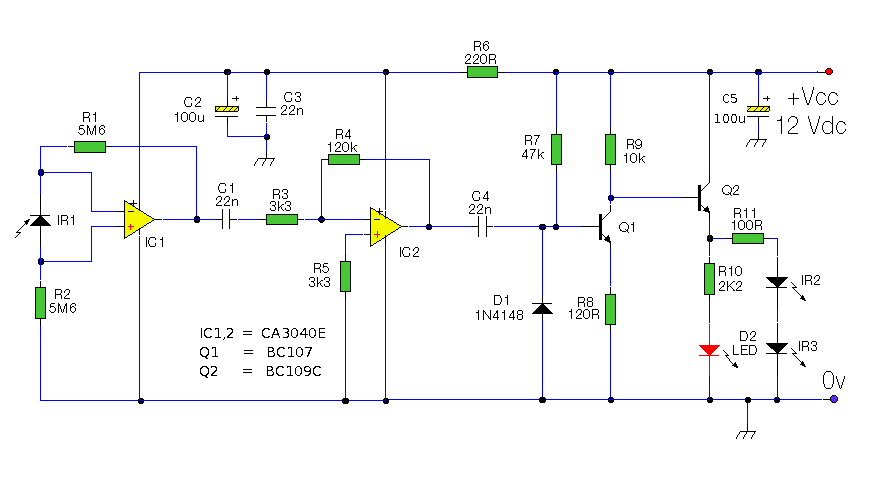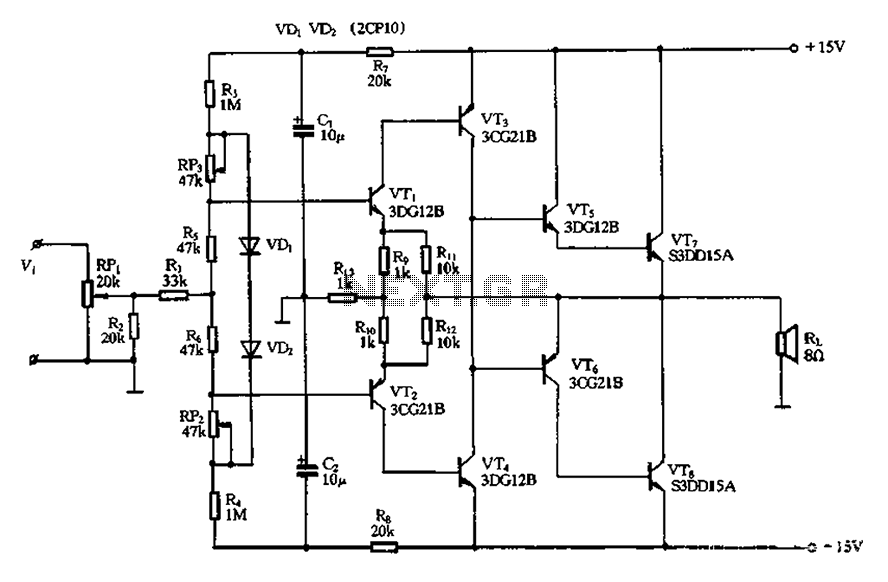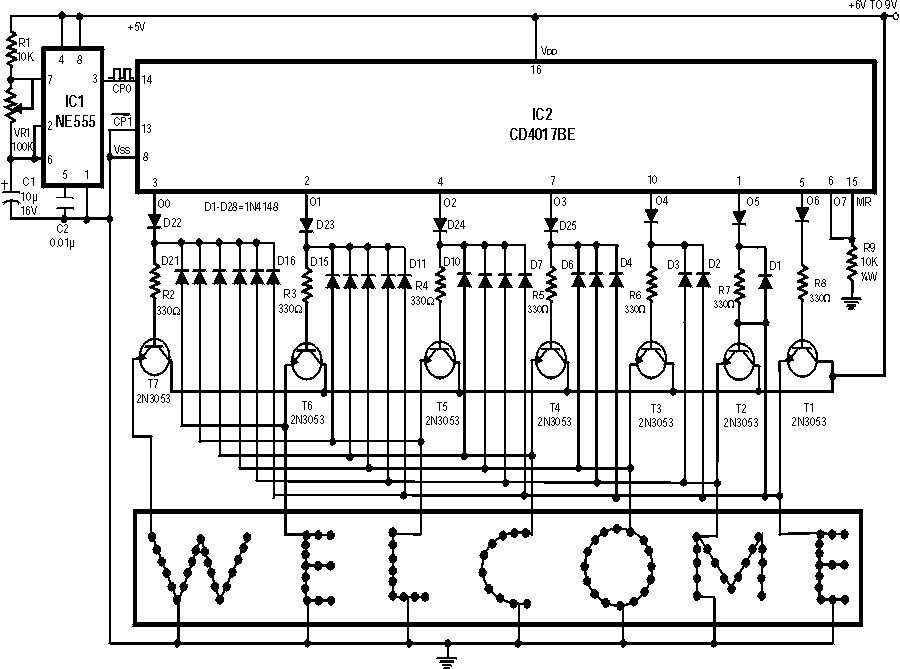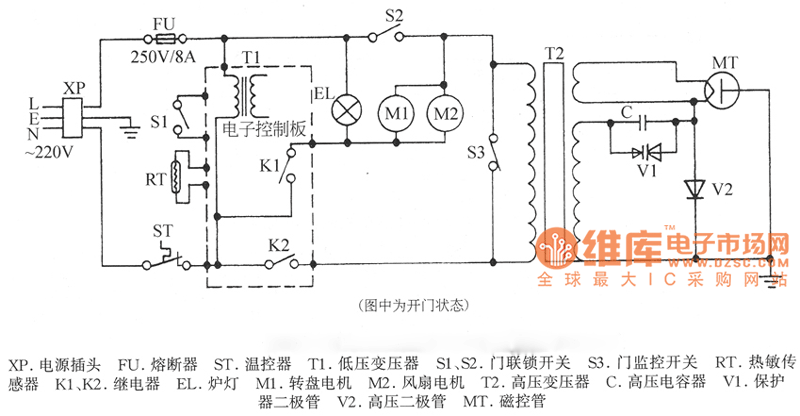
StunGun circuit

The Electronic Dazer is a modern, portable, personal-protection appliance. It generates high potential energy to ward off vicious animals or other attackers. It is an aid to help escape from a potentially dangerous situation. The device develops about 2,000 volts. Higher voltages may be attained by adding additional multiplier stages, but it should be noted that those stages will also increase the overall size of the unit. WARNING: THIS DEVICE IS NOT A TOY! We present it for EDUCATIONAL and EXPERIMENTAL purposes ONLY. The circuit develops about 2000 volts at a respectable amperage. It can cause you pain and even damage if you become careless and touch its output terminals.
The Electronic Dazer operates using a high-voltage generation circuit designed to produce a significant electrical discharge. The core component is typically a DC to DC converter, which steps up a low voltage input from a battery (often a 9V or 12V battery) to a high voltage output. The circuit may utilize components such as a transformer, oscillators, and capacitors to achieve the desired voltage levels.
The design might include a square wave oscillator to drive the transformer, allowing for efficient energy transfer during the voltage step-up process. This oscillator can be implemented using a simple transistor or a dedicated IC, which generates a high-frequency signal. The transformer steps up the voltage to the desired level, in this case, around 2,000 volts, which is sufficient for personal protection applications.
To enhance the voltage output, additional multiplier stages can be integrated into the circuit. These stages typically consist of diodes and capacitors arranged in a Cockcroft-Walton configuration, which allows for further voltage multiplication without significantly increasing the size of the transformer. However, it is essential to consider that adding more stages will increase the physical dimensions of the device and may also introduce complexities in circuit design and stability.
Safety precautions must be emphasized when working with high-voltage circuits. Proper insulation, secure casing, and warning labels are critical to prevent accidental contact with high-voltage terminals. Additionally, the device should only be used in controlled environments, considering the potential for harm if misused.
Overall, the Electronic Dazer serves as a practical example of high-voltage circuit design, highlighting the balance between portability, functionality, and safety in personal protection devices.The Electronic Dazer is a modern, portable, personal-protection appliance. It generates hight potential energy to ward off vicious animals or other attackers. It is an aid to help exape from a potentially dangerous situation. the device develops about 2,000 volts. Higher voltages mabe be attained by adding aditional multiplier stages, but it should be noted that those stage will also increase the overal size of the unit. WARNING: THIS DEVICE IS NOT A TOY! We present it for EDUCATIONAL and EXPERIMENTAL purposes ONLY. The circuit develops about 2000 volts at a respectable amperage. It can cause you pain and even damage if you become careless and touch its output terminals. 🔗 External reference
The Electronic Dazer operates using a high-voltage generation circuit designed to produce a significant electrical discharge. The core component is typically a DC to DC converter, which steps up a low voltage input from a battery (often a 9V or 12V battery) to a high voltage output. The circuit may utilize components such as a transformer, oscillators, and capacitors to achieve the desired voltage levels.
The design might include a square wave oscillator to drive the transformer, allowing for efficient energy transfer during the voltage step-up process. This oscillator can be implemented using a simple transistor or a dedicated IC, which generates a high-frequency signal. The transformer steps up the voltage to the desired level, in this case, around 2,000 volts, which is sufficient for personal protection applications.
To enhance the voltage output, additional multiplier stages can be integrated into the circuit. These stages typically consist of diodes and capacitors arranged in a Cockcroft-Walton configuration, which allows for further voltage multiplication without significantly increasing the size of the transformer. However, it is essential to consider that adding more stages will increase the physical dimensions of the device and may also introduce complexities in circuit design and stability.
Safety precautions must be emphasized when working with high-voltage circuits. Proper insulation, secure casing, and warning labels are critical to prevent accidental contact with high-voltage terminals. Additionally, the device should only be used in controlled environments, considering the potential for harm if misused.
Overall, the Electronic Dazer serves as a practical example of high-voltage circuit design, highlighting the balance between portability, functionality, and safety in personal protection devices.The Electronic Dazer is a modern, portable, personal-protection appliance. It generates hight potential energy to ward off vicious animals or other attackers. It is an aid to help exape from a potentially dangerous situation. the device develops about 2,000 volts. Higher voltages mabe be attained by adding aditional multiplier stages, but it should be noted that those stage will also increase the overal size of the unit. WARNING: THIS DEVICE IS NOT A TOY! We present it for EDUCATIONAL and EXPERIMENTAL purposes ONLY. The circuit develops about 2000 volts at a respectable amperage. It can cause you pain and even damage if you become careless and touch its output terminals. 🔗 External reference





